![]()
![]()
![]()
Use LEFT and RIGHT arrow keys to navigate between flashcards;
Use UP and DOWN arrow keys to flip the card;
H to show hint;
A reads text to speech;
33 Cards in this Set
- Front
- Back
|
Where and what are the Bronchioles |
Bronchioli are the passageways by which air passes through the nose or mouth |
|
|
Where is the Pharynx and what passes through it |
O2 & Co2 pass through the Pharynx after the gases pass by the tongue As well as food which goes through into the esophagus |
|
|
Where is the Larynx and what does it do |
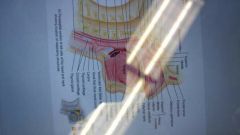
Anterior to Pharynx The larynx, also known as the voicebox, is a chamber at the top of the windpipe that uses two bands of muscle (vocal cords) to constrict and vibrate on exhalation, creating the human voice. Connects Pharynx to Trachea |
|
|
What are the Alveoli and where are they located |
Gas exchange of oxygen and carbon dioxide takes place in the alveoli. Oxygen from the inhaled air diffuses through the walls of the alveoli and adjacent capillaries into the red blood cells. The oxygen is then carried by the blood to the body tissues. Located in the Lungs |
|
|
What is the Internal Naris/Choana and where is it |
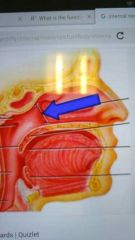
Serves as a filter for the respiratory system, keeping particles from making it into the trachea and the lungs. In addition to cleaning out the air the internal nares also provide warmth and moisture to the air as it makes its makes its way to the lungs. |
|
|
What is the external Naris and where is it? |
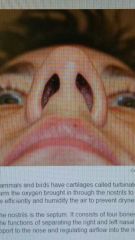
They are where oxygen enters the body |
|
|
What does the Nasal Vestibule do and where is it? |

Most anterior part of nasal cavity which has small hairs called VIBRISSAE who filter dust and other matter that is breathed in. |
|
|
What does the Nasal Concha do and where is it? |
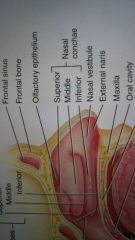
It is named liked a conch shell because its a shell shaped bojed that protrudes into the breathing passage of the nose in humans. Its divided into 4 groove like nasal airways and are responsible for forcing inhaled air flow in a steady, regulat pattern around the surfave area of the nose area which cleand and warms the inhaled air in preparation for the lungs |
|
|
What does the Nasal Meatus do and where is it? |
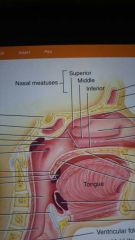
A nasal meatus is a nasal passage of the Nasal cavity, a meatus is a passage or opening in the body, especially one which is open to the exterior. |
|
|
Hard Palate does? and where is it? |

The hard palate is important for feeding and speech. |
|
|
Soft Palate does? and where is it? |
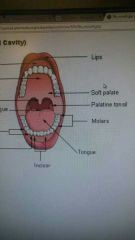
It is responsible for closing off the masal lassahes during the act of swalling, and also for closing off the airway. During sneezing, it protexts the nsal passage by diverting a portion of the excreted subtance to the mouth. |
|
|
Uvula does? and where is it? |
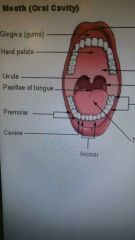
During swallowing the soft palate and uvula move together to close of the nasopharynx and prevent food from entering the nasal cavity. Also helps keep throat libricated with saliva glands |
|
|
Pharynx does? And where? |
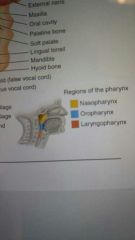
The Pharynx is the body cavity that connects the nasal and oral cavities with the larynx and esophagus. It is commonly referred to as the throat. |
|
|
Fauce does? And where? |
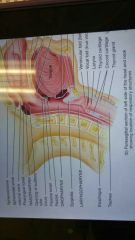
Opening in the mouth |
|
|
Nasopharynx, of the three pharynx anatomical regions which one is it? |
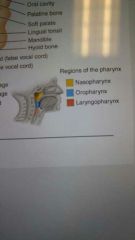
|
|
|
Oropharynx, of the three pharynx anatomical regions which one is it? |
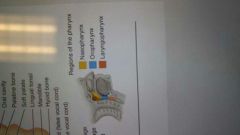
|
|
|
Laryngopharynx, of the three pharynx anatomical regions which one is it? |
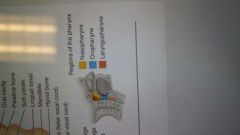
|
|
|
Pharyngeal tonsil, does? And where? |
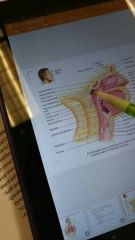
Tonsils are part of the lymphatic system located in the back of the throat and into the nasal cavity. Tonsils and adenoids are located near the entrance to the breathing passages where they can catch incoming infections. They sample bacteria and viruses and can become infected themselves. |
|
|
Palantine Tonsils |
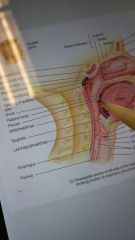
Tonsils are part of the lymphatic system located in the back of the throat and into the nasal cavity. Tonsils and adenoids are located near the entrance to the breathing passages where they can catch incoming infections. They sample bacteria and viruses and can become infected themselves. |
|
|
Lingual Tonsil |
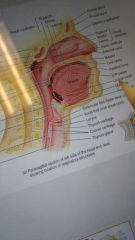
Tonsils are part of the lymphatic system located in the back of the throat and into the nasal cavity. Tonsils and adenoids are located near the entrance to the breathing passages where they can catch incoming infections. They sample bacteria and viruses and can become infected themselves. |
|
|
Larynx does? And where? |
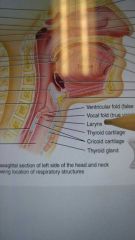
Connects Pharynx & Trachea and is the part of the body that creates voice |
|
|
Glottis does? And where? |
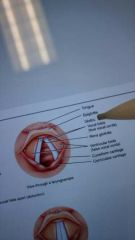
Sound productuon that involves moving the vocal folds close together is called glottal. Glottis is the part of the larynx that contains vocal cords |
|
|
Epi glottis does? And where? |
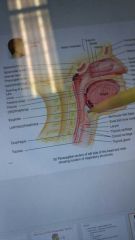
A flap of cartilage at the root of the tongue which is depressed during swallowing to cover the opening of the windpipe |
|
|
Whats the branches of the bronchial tree? Biggest to smallest |
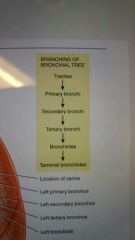
|
|
|
Lobes does? And where? |
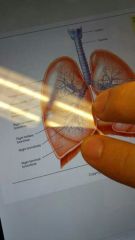
Seperate the three cavities of the lungs via fissures |
|
|
Tissue folds - Ventricular fold & Vocal Cord |
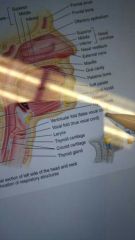
Ventricular fold prevents food from falling into the ventricular fold and holds breath
The Vocal fold vibrates their mucous membranes to produce voice |
|
|
Thyroid Cartilage is where? |
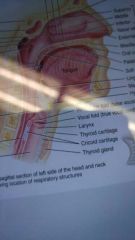
Is also know as the adams apples but thats all, just know where it is |
|
|
Circoid Cartilage is where? |
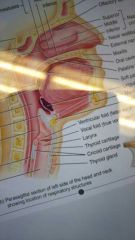
There to protect the airways, remeber its position |
|
|
Trachea does? And where? |
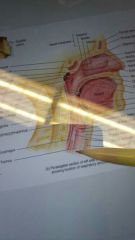
Provides airflow to the lungs from the mouth for respiration |
|
|
Primary bronchi are where on the Branching Bronchial Tree? |
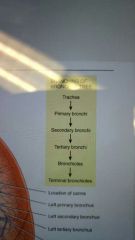
|
|
|
Terminal bronchiole are where on the Branching Bronchial Tree? And do what? |
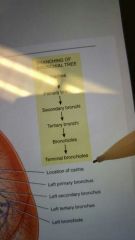
*Idk, ask someone* |
|
|
What connects accordingly for these 5 terms in order Aveloar duct Alveolar sac Respiratory bronchiole Terminal bronchiol Alveolus |
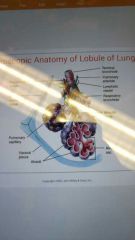
|
|
|
Alveoli does? And where? |
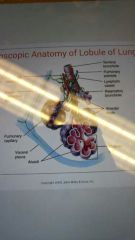
Alveoli are tiny sacs within our lungs that allow oxygen and carbon dioxide to move between the lungs and bloodstream. |

